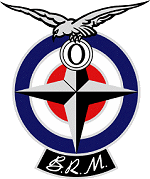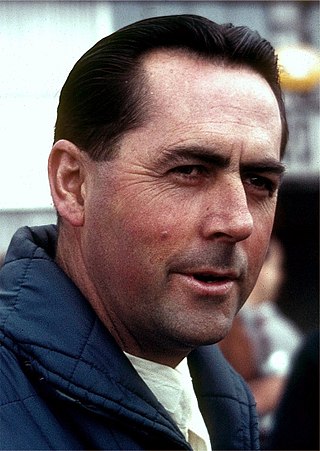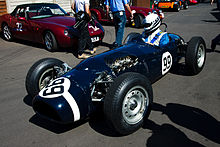
The Cooper Car Company is a British car manufacturer founded in December 1947 by Charles Cooper and his son John Cooper. Together with John's boyhood friend, Eric Brandon, they began by building racing cars in Charles's small garage in Surbiton, Surrey, England, in 1946. Through the 1950s and early 1960s they reached motor racing's highest levels as their mid-engined, single-seat cars competed in both Formula One and the Indianapolis 500, and their Mini Cooper dominated rally racing. The Cooper name lives on in the Cooper versions of the Mini production cars that are built in England, but is now owned and marketed by BMW.
Harry Ferguson Research Limited was a British company founded by Harry Ferguson who was mostly known as "the father of the modern farm tractor". He was also a pioneer aviator, becoming one of the first to build and fly his own aeroplane in Ireland, and also went on to develop four-wheel drive systems for cars including pioneering their use in Formula One racing cars. The company was based in Siskin Drive, in Coventry, England.

Coventry Climax was a British forklift truck, fire pump, racing, and other speciality engine manufacturer.

British Racing Motors (BRM) was a British Formula One motor racing team. Founded in 1945 and based in the market town of Bourne in Lincolnshire, it participated from 1951 to 1977, competing in 197 grands prix and winning seventeen. BRM won the constructors' title in 1962 when its driver Graham Hill became world champion. In 1963, 1964, 1965 and 1971, BRM came second in the constructors' competition.

The 1961 British Grand Prix was a Formula One motor race, held on 15 July 1961 at the Aintree Circuit, near Liverpool. It was race 5 of 8 in both the 1961 World Championship of Drivers and the 1961 International Cup for Formula One Manufacturers.

The 1961 Formula One season was the 15th season of Formula One motor racing. It featured the 1961 World Championship of Drivers and the 1961 International Cup for F1 Manufacturers, which were contested concurrently from 14 May to 8 October over an eight race series. The season also included numerous non-championship races for Formula One cars.

The 1960 Formula One season was the 14th season of the FIA's Formula One motor racing. It featured the 11th FIA World Championship of Drivers, the third International Cup for F1 Manufacturers and numerous non-championship Formula One races. The World Championship commenced on 7 February and ended on 20 November after ten races.

Peter Westbury was a British racing driver from England. He participated in two World Championship Formula One Grands Prix, scoring no championship points. In 1969 he raced a Formula 2 Brabham-Cosworth, driving in his first Grand Prix in the 1969 German Grand Prix. He finished ninth on the road, fifth in the F2 class. The following year he failed to qualify for the 1970 United States Grand Prix driving a works BRM, after an engine failure.

Major Anthony Peter Roylance Rolt, MC & Bar, was a British racing driver, soldier and engineer. A war hero, Rolt maintained a long connection with the sport, albeit behind the scenes. The Ferguson 4WD project he was involved in paid off with spectacular results, and he was involved in other engineering projects.
John Eric George "Jack" Fairman was a British racing driver from England. He participated in 13 Formula One Grands Prix, making his debut on 18 July 1953. He scored a total of five championship points, all of which came in the 1956 season.

Nota Sports and Racing Cars is an automobile manufacturer in Australia that was established in 1952. Their best-selling car was the Nota Fang, with 105 cars built between 1968 and 1975.

Team Lotus was the motorsport sister company of English sports car manufacturer Lotus Cars. The team ran cars in many motorsport categories including Formula One, Formula Two, Formula Ford, Formula Junior, IndyCar, and sports car racing. More than ten years after its last race, Team Lotus remained one of the most successful racing teams of all time, winning seven Formula One Constructors' titles, six Drivers' Championships, and the Indianapolis 500 in the United States between 1962 and 1978. Under the direction of founder and chief designer Colin Chapman, Lotus was responsible for many innovative and experimental developments in critical motorsport, in both technical and commercial arenas.

The Lotus 33 was a Formula One car designed by Colin Chapman and Len Terry and built by Team Lotus. A development of the successful Lotus 25, in the hands of Jim Clark it won five World Championship Grands Prix in 1965, taking Clark to his second World Championship.
Rob Walker Racing Team was a privateer team in Formula One during the 1950s and 1960s. Founded by Johnnie Walker heir Rob Walker (1917–2002) in 1953, the team became F1's most successful privateer in history, being the first and only entrant to win a World Championship Formula One Grand Prix without ever building their own car.

The Lotus 18 was a race car designed by Colin Chapman for use by Lotus in Formula Junior, Formula Two, and Formula One.
Four-wheel drive (4WD) has only been tried a handful of times in Formula One. In the World Championship era since 1950, only eight such cars are known to have been built.

The BRM P67 was an experimental Formula One car, designed by Tony Rudd and built by the British Racing Motors team in Bourne, Lincolnshire, England, for the 1964 Formula One season.

The Cooper T51 was a Formula One and Formula Two racing car designed by Owen Maddock and built by the Cooper Car Company for the 1959 Formula One season. The T51 earned a significant place in motor racing history when Jack Brabham drove the car to become the first driver to win the World Championship of Drivers with an engine mounted behind them, in 1959. The T51 was raced in several configurations by various entrants until 1963 and in all no less than 38 drivers were entered to drive T51s in Grand Prix races.

The Cooper T53 is a Formula One car built by British motorsport team Cooper for the 1960 Formula One season. Jack Brabham drove it to his second World Championship that year, and with teammate Bruce McLaren gave Cooper its second Constructors' Championship.
Intercontinental Formula was an open wheel, single seater motor-racing formula introduced in 1961 as an alternative to Formula One. As its name implies it was hoped to encourage participation from the United States and Europe, but ultimately the handful of races which ran under the formula all took place in Great Britain, and only for one year.















